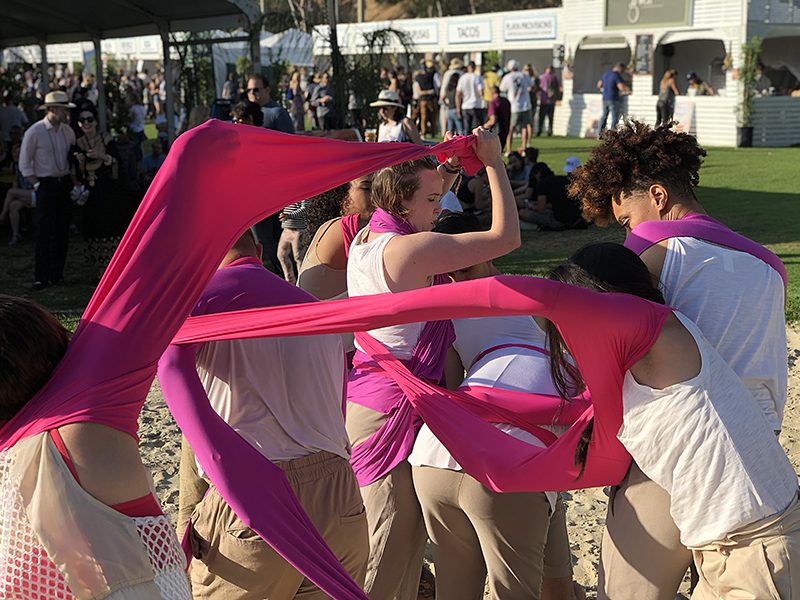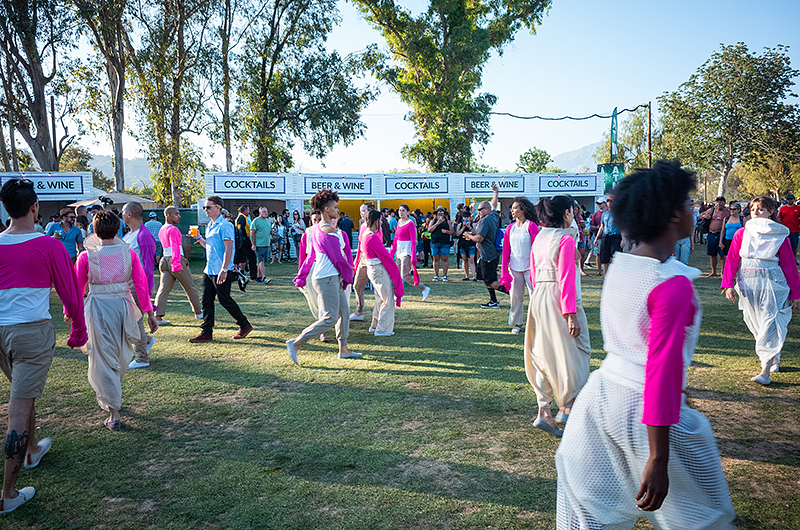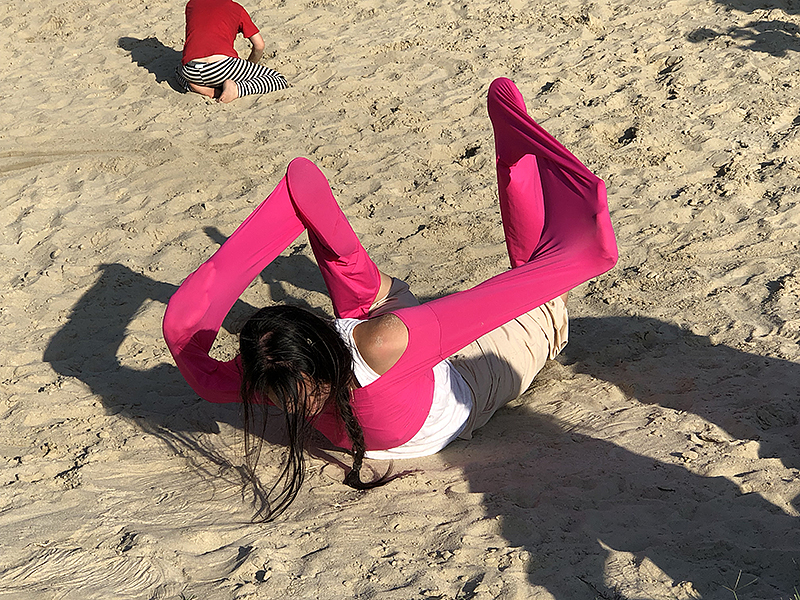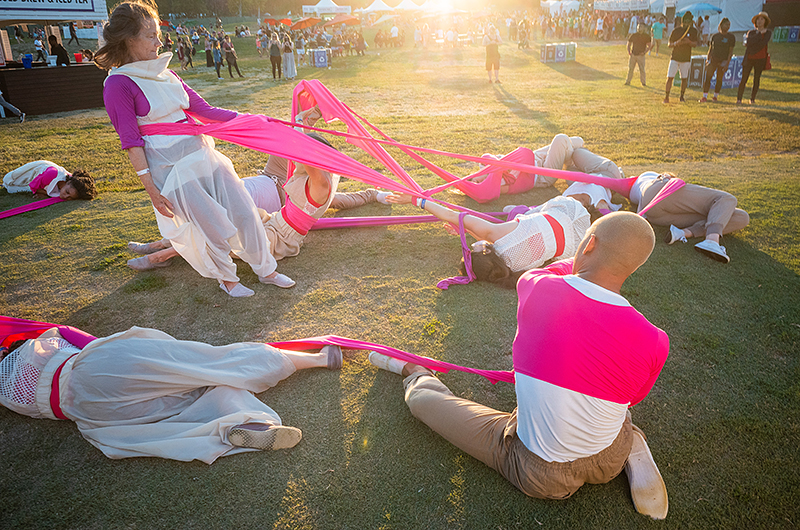Fulcrum Arts and Goldenvoice Present:
Microcosmos: Intelligence Moves
The Laboratory for Embodied Intelligences (LEI) at Arroyo Seco Weekend, June 23-24, The Rosebowl, Pasadena
LEI Artistic Director / Co-Founder:
Nina Waisman
LEI Movement Expert / Co-Founder:
Flora Wiegmann
LEI Credits and Thanks Here
Related Podcast here
The Laboratory for Embodied Intelligences (LEI) is a collective of artists, scientists and other experts working to create experiences that allow humans to “try on” non-human perspectives.
LEI offers performances, art-videos, public movement/science workshops, installations, panels, and think tanks lasting from 2 hours to 2 weeks. Projects to date have been shaped by LEI director/co-founder Nina Waisman and co-founder/movement-expert Flora Wiegmann, in collaboration with context-determined teams of artists, scientists and enthusiasts of many stripes. LEI believes we have much to gain – aesthetically, sensorially, practically, politically – by approaching intelligence from a less anthropocentric perspective, considering intelligences in entities with different bodies and sensory apparatus, living in different time scales and environments than we require.
LEI has begun this pursuit with works focused on making bacterial cultures viscerally accessible to humans. Why? We evolved from microbial bacteria, yet only recently did we learn that “all mobile unicellular organisms possess the fundamental characteristics of nervous systems” (Dr. Lori Marino). Perhaps fundamental cognitive capacities and “modes of reason” we think unique to humans belong in some form to bacteria. We know they communicate – in fact, they are multi-lingual. They have survived and communicated with each other over 3.5 billion years. Surely there are a few things we can learn from cultures exponentially more long-lived and adapted than we are? Looking outward, astrobiologists agree that microbes are the most likely form of life we will encounter out in the cosmos. Can our terrestrial bacteria help us communicate with these extraterrestrials? Closer to home, humans have 150 times more bacterial DNA in and on their bodies than human DNA: much of this microbial culture is in direct dialogue with our so-called intellectual processes, individually and collectively.
Intelligence moves between entities.
Program Notes:
Prologue
Human thought and signals are based on chemical and physical abilities latent in bacteria
Dr. Lori Marino
Mindness is the internalization of movement
Dr. Rodolfo Llinas, NYU
Single cells
Bacteria have figured out a way to use one cell, a few microns in diameter, to sense a much larger environment.
By liquifying paths through their cell matter bacteria are able to move their organs where needed and create new appendages on the fly.
Bacteria cover us in an invisible body armor.
They digest our food, they make our vitamins, they educate our immune systems.
They impact our emotions, our memory, our cognition.
Behavior wires the brain and the brain shapes behavior.
Attach, exchange, leave.
Multi-cell colonies
The kind of junction between individuals indicates the quality of communication between them.
Bacteria turn on group behaviors that are only successful when all of the cells participate in unison.
Bacteria make chemical words, they recognize those words, they are multilingual.
A signal by itself may not be meaningful, it’s all in what an individual does with a signal.
How would we know if we came across non-human intelligence – would we recognize it?
A new generation of bacteria is born every 20 minutes.
Replication, mutation, contagion
Benign infectiousness
Restrained predation
Humans
We never had a clue what intelligence was – and still it’s the same.
Kanna Rajan, former director of the Artificial Intelligence program at NASA
We are going to discover the universe we are prepared to discover.
Nathalie Cabrol, Senior Research Scientist and Director of the Carl Sagan Center
The scientific information and quotations above were gathered during interviews with lead scientists at SETI Institute, NASA, NYU, Stanford, etc, as well as through research papers by experts in astrobiology, bacteria, microbiology and neuroscience.
Why Microbes?
All life on earth is deeply dependent on bacteria: bacteria create oxygen and soil, they digest our food, equilibrate our moods, maintain our health – the list goes on. Scientists agree that all earthly lifeforms evolved from bacteria. But even if you do not agree with evolutionary science, our mutual dependence on bacteria suggests that looking more deeply at their behavior is likely to locate patterns of connectedness between our behaviors and theirs – we couldn’t host them without this connectedness.
More peformance info here:
https://www.fulcrumarts.org/microcosmos-intelligence-moves/
About The Laboratory for Embodied Intelligences
The Laboratory for Embodied Intelligence is a collective of artists, scientists and other experts working to create experiences that allow humans to “try on” non-human perspectives, in order to learn from other species. LEI's approach is to collaborate with diverse community partners, incorporating a a range of mind-body perspectives. Using scientific findings about non-human creatures to (playfully and easily) tune human bodies into newly sensitive perception-machines, LEI aims to gain knowledge unavailable through classic scientific data analysis. LEI’s approach is supported by numerous interdisciplinary experts.
The fields of neuroscience and cognitive science have found that simply watching another body move triggers neurons in the viewer's brain to fire as if she, too, were doing the same movement. At the same time, unconsciously, the viewers muscles are primed to execute those motions. Watching others move, then, leads us to unconscioulsy play or try on their movement on our own bodies. This leads not only to learning, but also to bodily understandings of the viewed expereience - a deep alignment, and often an empathy with those viewed.
Through performances, workshops, are installations, panels and and dialogues, LEI seeks to give the public access to some of the vast treasure of behaviors and communication techniques invented and enacted by microbes. What can we learn from the highly successful behaviors and communication methods our microbial colleagues and ancestors employ? How do human logics and languages compare to microbial behaviors?
About Fulcrum Arts
Fulcrum Arts empowers artists to invent, inspire, and provoke. Fulcrum Arts' A×S (Art x Science) initiative embodies the integration of intuition and reason and further commemorates, in Pasadena, a textured conversation between the sciences and the humanities that has long been emblematic of the city’s history, and is equally fused with its future.
Why explore microbial behaviors?
Read the conceptual and scientific overview here.
Generously supported to date by:
Fulcrum Arts, Goldenvoice,
The 18th Street Arts Center, The Hammer Museum, SETI Institute Artist in Residence Program, and The Lucas Artists Residency Program at Montalvo Arts Center .
The Laboratory for Embodied Intelligences (LEI)
Director/Co-Founter: Nina Waisman
Movement expert/Co-Founder: Flora Wiegmann
2018 Collaborators and Performers:
Costumes: Milan DelVecchio
Dancer-collaborators:
Jamie Carr, Madison Clark, Venus Fields, Kearian Giertz, Maya Gingery, Kai Hazelwood, Colleen Hendricks, Sarah Jacobs, Spencer K Jensen, Michelle Lai, Carol Mcdowell, Samantha Mohr, Natali Micciche, Nguyen Nguyen, and Michelle Sui.
Thanks
Huge thanks to the generous supporters named below, as well as those listed here!!!
Fulcrum Arts
Fulcrum Arts empowers artists to invent, inspire, and provoke. Fulcrum Arts' A×S (Art x Science) initiative embodies the integration of intuition and reason and further commemorates, in Pasadena, a textured conversation between the sciences and the humanities that has long been emblematic of the city’s history, and is equally fused with its future.
Goldenvoice
Goldenvoice creates and operates music festivals including coachella valley music, arts festival, and stagecoach..
18th Street Arts Center
Nina Waisman’s residency and its associated collaborative public events and performances are made possible by The 18th Street Arts Center, with funding provided by City of Santa Monica Cultural Affairs Department, the California Arts Council, and The James Irvine Foundation. 18th Street Art Center is the leading artist residency in Southern California, with a mission is to provoke public dialogue through contemporary art making.
The Hammer Museum
The Hammer Museum’s Public Engagement program is supported, in part, by the Los Angeles County Board of Supervisors through the Los Angeles County Arts Commission. In Real Life: Studio is a Public Engagement project organized by January Parkos Arnall, curatorial associate, Public Engagement.
SETI Institute’s Artist in Residence Program
The SETI Artist in Residence Program facilitates cross-disciplinary artistic expression dedicated to exploring, understanding, and explaining the origin, nature and prevalence of life in the universe. The Program fosters an exchange of ideas between artists and scientists, and encourages contemporary artistic practices that allow us to experience life on this planet and beyond in new ways. Learn more about the SETI Artist in Residence Program, here.
SETI Institute
SETI Institute’s mission is to explore, understand, and explain the origin and nature of life in the universe, and to apply the knowledge gained to inspire and guide present and future generations. SETI has a passion for discovery, and for sharing knowledge as scientific ambassadors to the public, the press, and the government. SETI Institute is a private, nonprofit organization dedicated to scientific research, education and public outreach. The Institute comprises three centers, the Center for SETI Research, the Carl Sagan Center for the Study of Life in the Universe and the Center for Education and Public Outreach. Founded in November 1984, SETI Institute began operations on February 1, 1985. Today it employs over 130 scientists, educators and support staff. Research at the Institute is anchored by three centers, the Center for SETI Research, the Center for Education and Public Outreach and the Carl Sagan Center for the study of life in the universe. More information here.
Montalvo Art Center and Residency Program
The Sally and Don Lucas Artists Residency Program (LAP) is designed to offer artists from a range of disciplines an environment conducive to individual and collaborative creative practice. Seeking to stimulate an energetic exchange of ideas between culturally diverse Fellows and across varied artistic fields and scholarly disciplines, the residency has earned international recognition as a model of curato rial practice supporting the development of new and challenging contemporary work.
The LAP welcomes sixty artists a year into the program. Residencies are offered in all contemporary artistic disciplines including the visual arts, design, literary arts, film, choreography, performance art, music and composition, and teaching artists. The LAP welcomes artist’s collaborators from overlapping fields, including science, technology, and other scholarly research. The Program is the first in the United States to offer an annual Culinary Artist Residency. For more information about Montalvo Arts Center, click here.
Bios
Nina Waisman, Director
As a former dancer turned multi-media artist, Nina Waisman is fascinated by the critical roles that movement and sensation play in forming thought. Her interactive sound installations, videos and collaborative performances highlight the subliminal training and possible hacking of such embodied thinking. These works focus on related issues including surveillance, invisible labor, machine-human feedback loops, nanotechnology. Venues include House of World Cultures, Berlin; LAXART; CECUT, Tijuana; OCMA; the Beall Center for Art & Technology, Zero1 Biennial, the San Diego Museum of Art, The New Children's Museum in San Diego. She has taught at institutions such as Cal Arts, SFAI, UCSD, and spent 2015 as an artist in residence at SETI Institute. Waisman is starting a new series of collaborative artworks exploring the role of embodiment in forming non-human intelligences, ranging from microbial on through plant, animal and extraterrestrial intelligences. More info: http://www.ninawaisman.net
Flora Wiegmann, Founding Member, Movement Expert
Flora Wiegmann is a Los Angeles-based dancer and choreographer. She works in both live performance and film, often making research-based work that is specific to its particular site. She has had the opportunity to collaborate with artists such as Fritz Haeg, Silke Otto-Knapp, Alix Lambert, Amy Granat, Miljohn Ruperto, Nina Waisman and Tom Lawson. Her projects have been presented at the ICA, Philadelphia; The Kitchen, New York; the California Biennial and LAXART in California, The David Roberts Foundation and The Camden Arts Centre, London; The Banff Center for Creativity in Canada, and Université Rennes in France. More info: http://florawiegmann.com

Pictured: Madison Clark, Kearian Giertz, Kai Hazelwood, Colleen Hendricks, Sarah Jacobs, Spencer K Jensen, Michelle Lai, Nguyen Nguyen
Photo: Robert Crouch

Pictured: Kearian Giertz, Maya Gingery, Kai Hazelwood, Colleen Hendricks, Sarah Jacobs, Spencer K Jensen, Michelle Lai, Carol Mcdowell, Samantha Mohr, Natali Micciche, Nguyen Nguyen, and Michelle Sui Photo: Robert Crouch

Pictured: Jamie Carr, Madison Clark, Venus Fields, Kearian Giertz, Maya Gingery, Kai Hazelwood, Colleen Hendricks, Sarah Jacobs, Spencer K Jensen, Michelle Lai, Carol Mcdowell, Samantha Mohr, Natali Micciche, Nguyen Nguyen, and Michelle Sui
Photo: Robert Crouch

Pictured: Michelle Lai, Photo: Robert Crouch

Pictured: Jamie Carr, Madison Clark, Venus Fields, Kearian Giertz, Maya Gingery, Kai Hazelwood, Colleen Hendricks, Sarah Jacobs, Spencer K Jensen, Michelle Lai, Carol Mcdowell, Samantha Mohr, Natali Micciche, Nguyen Nguyen, and Michelle Sui
Photo: Robert Crouch